- Home
- Sue Grafton
N is for NOOSE Page 5
N is for NOOSE Read online
Page 5
When I woke up at seven, my nose felt like a Popsicle and my breath was visible in puffs against the wan morning light. I showered in tepid water, dried myself shivering, and dressed in haste. Then I dog trotted down the road to the Rainbow Cafe where I stoked up on another breakfast, sucking down orange juice, coffee, sausages, and pancakes saturated with butter and syrup. I told myself I needed all the sugar and fat to refuel my depleted reserves, but the truth was I felt sorry for myself and the food was the simplest form of consolation.
The coroner’s office was located on a side street in the heart of the downtown. In Nota County, the coroner is a four-year elected official, who in this case doubled as the funeral director for the county’s only mortuary. Nota County is small, less than two thousand square miles, tucked like an afterthought between Inyo and Mono counties. The coroner, Wilton Kirchner III, generally referred to as Trey, had occupied the position for the past ten years. Since there was no requirement for formal training in forensic medicine, all coroner’s cases were autopsied by a forensic pathologist under contract to the county.
In the event of a homicide in the county, the Nota County Coroner handles the on-scene investigation, in conjunction with the Sheriffs Department’s investigator and an investigator from the Nota County District Attorney’s office. The forensic autopsy is then conducted in the “big city” by a pathologist who does several homicide autopsies per month and is called to court numerous times during the year to testify. Since Nota County only has one homicide every two years or so, the coroner prefers that an outside agency provide its expertise, in both autopsy services and testimony.
Kirchner & Sons Mortuary appeared to have been a private residence at one time, probably built in the early twenties with the town growing up around it. The architectural style was Tudor with a facade of pale red brick trimmed in dark-painted timbers. Thin cold sunlight glittered against the leaded glass windows. The surrounding lawns were dormant, the grass as drab and brittle as brown plastic. Only the holly bushes lent any color to the landscape. I could imagine a time when the house might have sat on a sizeable piece of land, but now the property had shrunk and the lots on either side sported commercial establishments: a real estate office and a modest medical complex.
Trey Kirchner came out to the reception area when he heard I was there, extending a hand in greeting as he introduced himself. “Trey Kirchner,” he said. “Selma called and said you’d be in here today. Nice to meet you, Miss Millhone. Come on back to my office and let’s find out what you need.”
Kirchner was in his mid-fifties, tall, broadshouldered, with a waistline only slightly softer than it might have been ten years before. His hair was a clean gray, parted on the side and trimmed short around his ears. His smile was pleasant, creating concentric creases on either side of his mouth. He wore glasses with large lenses and thin metal frames. The corners of his eyes drooped slightly, somehow creating an expression of immense sympathy. His suit was close-fitting, well pressed, and the dress shirt he wore looked freshly starched. His tie was conservative, but not somber. Altogether, he presented an air of comforting competence. There was something solid about him; a man who, by nature, looked like he could absorb all the sorrow, confusion, and rage generated by death. I followed him down a long corridor and into his office, which had served as the dining room when the house was first built. The carpet was pale, the wood floors pickled to the color of milk-washed pine. The drapes were beige, silk or shantung, some fabric with a touch of sheen. The mortuary decor leaned to wainscoting, topped with wallpaper murals showing soft mountain landscapes, forests of evergreens with paths meandering through the woods. This was a watercolor world; pastel skies piled with clouds, the faintest suggestion of a breeze touching the tips of the wallpaper trees. On either side of the corridor at intervals, wide sliding doors had been pushed back to reveal the slumber rooms, empty of inhabitants, bare except for the ranks of gray metal folding chairs and a few potted ferns. The air was cool, underheated, spiced with the scent of carnations though none were in view. Perhaps it was some weird form of mortuary air freshener wafting through the vents. The entire environment seemed geared to somnambulistic calm.
The office we entered seemed designed for the public, not a book, a file, or a piece of paper in sight. I suspected somewhere in the building Trey Kirchner had an office where the real work was done. Somewhere out of sight, too, was the autopsy paraphernalia: cameras, X-ray equipment, stainless steel table, Stryker saw, scalpels, hanging scale. The room where we sat was as bland as a pudding ��� no smell of formalin, no murky Mason Jars filled with snippets of organs ��� giving no indication of the mechanics of the body’s preparation for cremation or burial.
“Have a seat,” he said, indicating two matching upholstered chairs arranged on either side of a small side table. His manner was relaxed, pleasant, friendly, curiously impersonal. “I take it you’re here about Tom’s death.” He reached over and opened the drawer, pulling out a flat manila folder containing a five-page report. “I ran a copy of the autopsy report in case you’re interested.”
I took the folder. “Thanks. I thought I might have to talk you into this.”
He smiled. “It’s public record. I could have popped it in the mail and saved you a trip if Selma’d asked for it sooner.”
“Tom’s death was classified as a coroner’s case?”
“Of necessity,” he said. “You know he died out on Highway 395 with no witnesses and probably not much warning. He hadn’t seen his doctor in close to a year. We figured it was his heart, but you never really know about these things until the post. Could have been an aneurysm. Anyway, Calvin Burkey did the autopsy. He’s the forensic pathologist for Nota and Mono counties. Couple of us in attendance. Nothing remarkable showed up. No surprises, nothing unexpected. Tom died of a massive acute myocardial infarction due to severe arteriosclerosis. You’ll see it. It’s all there. Sections of the coronary artery confirmed ninety-five percent to one hundred percent occlusion. Sixty-three years old. Really, it’s amazing he lasted as long as he did.”
“Nothing else came to light?”
“In the way of abnormalities? Nope. Liver, gallbladder, spleen, kidneys were all unremarkable. Lungs looked bad. He’d been smoking all his life, but there was no indication of invasive disease. He’d eaten recently. According to our report, he’d stopped off at a cafe for a bite of supper. No pills or capsules in his digestive system and the toxin report was clear. What makes you ask?”
“Selma said he’d been losing weight. I wondered if he knew something he wasn’t telling her.”
“No ma’am. No cancer, if that’s what you mean. No tumors, no blood clots, and no hemorrhaging, aside from the myocardium,” he said. “Doc said there were signs of a minor heart attack sometime in the past.”
I thought about it. “So maybe he knew his days were numbered. That would give him reason to brood.”
“Could be,” he said. “Tom wasn’t in the peak of health, I can assure you of that. The absence of pathology doesn’t necessarily mean you feel all that good. I knew him for years and never heard him complain, but he was sixty pounds overweight. Smoked like a chimney, drank like a fish, just to cover both clich��s. He was a hell of an investigator, I can tell you that. What’s Selma’s worry?”
“It’s hard to say. I think she feels he was holding out on her, keeping secrets of some kind. She didn’t press him for answers so now it’s unfinished business and it bothers her a lot.”
“And she has no idea what it was?”
“It might not be anything, which is where I come in. Do you have any theories?”
“I don’t think you’ll turn up anything scandalous. Tom was churchgoing, a good soul. Well liked, well thought-of in the community, generous with his time. If he had any faults, I’d have to say he was straitlaced, too rigid. He saw the world in terms of all black or all white with not a lot in between. I guess he could see the gray, but he never knew what to do with it. He didn’t beli
eve in bending the rules, though I’ve seen him do it from time to time. He was a real straight-ahead guy, but that’s good in my opinion. We could use a few more like him. We’re going to miss him around here.”
“Did you spend any time with him in the past few weeks?”
“Nothing to speak of. Mostly, I saw him in the context of his job. Not surprisingly, the county sheriff’s department and the coroner’s office are just like that,” he said, crossing his fingers. “I’d run into him around town. Played pool with him once. Sucked back a few beers. Bunch of us did a weekend fishing trip last fall, but it’s not like we laid around at night baring our souls. Fellow you ought to talk to is his partner, Rafe.”
“Selma mentioned him. What’s his last name?”
“LaMott.”
I sat in the rental car in the Kirchner & Sons parking lot, leafing through Tom Newquist’s autopsy report, his death certificate spelling out the particulars of his passing. Age, date of birth, Social Security number, and his usual address; the place and cause of his death and the disposition of his remains. He’d arrived at Nota County Hospital ER as a DOA, autopsied a day later, buried the day after that. On paper, his progression to the grave seemed all too swift, but in truth, once death occurs, the human body is just a big piece of meat quickly going sour. There was something flat and abrupt in the details… Tom Newquist deceased… his life neatly packaged; beginning, middle, and end. Under the death certificate was a copy of a hand-scrawled note that I gathered had been written by the CHP officer who found him in his truck.
At appx 21 50 2/3 Ambulance call to roadside 7.2 mi. out Hiway 395. Subj in pick-up, removed to side of road. CRP started @ 22 00. EMT from Nota Lake taking over @ appx. 22 15. Subj DOA on arrival at Nota Lake ER. Coroner notified.
The notation was signed “J. Tennyson.” The autopsy report followed; three typewritten pages detailing the facts as Trey Kirchner had indicated.
I’d been hoping the explanation was obvious, that Tom Newquist was caught in the grip of some terminal disease, his preoccupation as simple as an intimation of his mortality. This was not the case. If Selma’s perceptions were correct and he was brooding about something, the subject wasn’t an immediate threat to his health or well-being. It was always possible he’d been experiencing heart problems ��� angina pain, arrhythmia, shortness of breath on exertion. If so, he might have been weighing the severity of his symptoms against the consequences of consulting his physician. Tom Newquist might have seen enough death to view the process philosophically. He might have been more fearful of medical intervention than the possibility of dying.
I set the folder on the seat beside me and started the car. I wasn’t sure where to go next, but I suspected the logical move would be to talk to Tom’s partner, Rafer LaMott. I checked my map of Nota Lake and spotted the sheriff’s substation, which was part of the Civic Center on Benoit about six blocks west. The sun had been climbing through a thin layer of clouds. The air was chilly, but there was something lovely about the light. Along the main thoroughfare, the buildings were constructed of stucco and wood with corrugated metal roofs: gas stations, a drugstore, a sporting goods shop, and hair salon. Rimming the town was the untouched beauty of distant mountains. The digital thermometer on the bank sign showed that it was 42 degrees.
I parked across the street from the Nota Lake Civic Center, which also included the police station, the county courthouse, and assorted community services. The complex of administrative offices was housed in a building that had once been an elementary school. I know this because the words “Nota Lake Grammar School” were carved in block letters on the architrave. I could have sworn I could still see the faint imprint of construction paper witches and pumpkins where they’d been affixed to the windows with cellophane tape, the ghosts of Halloweens past. Personally, I hated grade school, having been cursed with a curious combination of timidity and rebellion. School was a minefield of unwritten rules that everyone but me seemed to sense and accept. My parents had died in a car crash when I was five, so school felt like a continuation of the same villainy and betrayal. I was inclined to upchuck without provocation, which didn’t endear me to the Janitor or classmates sitting in my vicinity. I can still remember the sensation of recently erupted hot juices collecting in my lap while students on either side of me flocked away in distaste. Far from experiencing shame, I felt a sly satisfaction, the power of the victim wreaking digestive revenge. I’d be sent down to the school nurse where I could lie on a cot until my Aunt Gin came to fetch me. Often at lunchtime… (before I learned to barf at will)… I’d beg to go home, swearing to look both ways when I was crossing the street, promising not to talk to strangers even if they offered sweets. My teachers rebuffed every plaintive request, so I was doomed to remain; fearful and anxious, undersized, fighting back tears. By the time I was eight, I learned to quit asking. I simply left when it suited me and suffered the consequences later. What were they going to do, shoot me down in cold blood?
The entrance to the Civic Center opened into a wide corridor that served as a lobby, currently undergoing renovations. File cabinets and storage units had been moved into the uncarpeted space. The walls were lined with panels of some unidentified wood. The ceiling was a low gridwork of acoustical tiles. Portions of the hallway were marked off with traffic cones strung together with tape, hand-lettered signs pointing to the current locations of several displaced departments.
I found the sheriffs substation, which was small and consisted of several interconnecting offices that looked like the “Before” photos in a magazine spread. Fluourescent lighting did little to improve the ambience, which was made up of a hodgepodge of technical manuals, wall plaques, glossy paneling, office machines, wire baskets, and notices taped to all the flat surfaces. The civilian clerk was a woman in her thirties who wore running shoes, jeans, and an M.I.T. sweatshirt over a white turtleneck. Her name tag identified her as Margaret Brine. She had chopped-off black hair, oval glasses with black frames, and a dusting of freckles under her powder and blush. Her teeth were big and square with visible spaces between.
I took out a business card and placed it on the counter. “I wonder if I might talk to Rafer LaMott.’.’
She picked up my card, giving it a cursory look. “Will he know what this is about?”
“The coroner suggested I talk to him about Tom Newquist.”
Her gaze lifted to mine. “Just a minute,” she said. She disappeared through a door in the rear that I assumed led into other offices. I could hear a murmur, and moments later Rafer LaMott appeared, shrugging himself into a charcoal brown sport coat. He was an African American in his forties, probably six feet tall, with a caramel complexion, closely cropped black hair, and startling hazel eyes. His mustache was sparse, and he was otherwise clean-shaven. The lines in his forehead resembled parallel seams in a fine-grained leather. The sports coat he wore over black gabardine pants looked like cashmere. His shirt was pate beige, his tie a mild brown with a pattern of black paperclips arranged in diagonal lines up and down the length.
He had my card in his hand, reading out the information in a slightly cocky tone. “Kinsey Millhone, P.I. from Santa Teresa, California. What can I help you with?”
I could feel a prickly sensation at the back of my neck. His expression was non-committal. Technically, he wasn’t rude, but he certainly wasn’t friendly and I sensed from his manner he was not going to be much help. I tried a public smile, nothing with any sincerity or warmth. “Selma Newquist hired me. She has some questions about Tom.”
He regarded me briefly and then moved through the gate at one end of the counter. “I have to be some place, but you can follow me out. What questions?”
I had no choice but to trot along beside him as he headed down the hall toward a rear entrance. “She says he was upset about something. She wants to know what it was.”
He pushed the door open and passed through, picking up his pace in a manner that suggested mounting agitation. I caught the door a
s it swung shut and passed through right after him. I had to two-step to keep up. He pulled his car keys from his pocket as he descended the steps. He walked briskly across the parking lot and slowed when he reached a nondescript, white compact car, which he proceeded to unlock. As he opened the car door, he turned to look at me. “Listen, here’s the truth and no disrespect intended. Selma. was always trying to pry Into Tom’s business, always pressing him for something just in case the poor guy had a fleeting thought of his own. The woman comes equipped with emotional radar, forever scanning her environment, trying to pick up matters of no concern to her. Repeat that and I’ll deny it so you can save your breath.”
“I have no intention of repeating it. I appreciate your candor ���”
“Then you can appreciate this,” he said. “Tom never said a word against her, but I can tell you from���
Chapter 5
*
I got in my car and headed back to Selma’s, still completely unenlightened. I couldn’t tell if Rafer knew something or if he was simply annoyed at Selma’s hiring a private detective. Oddly enough, I found his rudeness more inspirational than daunting. Tom had died without much warning, out on the highway with no opportunity to clean up his business. For the moment, I was operating on the assumption that Selma’s intuition was correct.
I left my car out in front and crossed the lawn to the porch. Selma’d left a note taped to the door saying she’d be over at the church until noon. I tried the door, which was unlocked, so I didn’t need the key she’d given me the night before. I let myself in, calling a hello as I entered in case Brant was on the premises. There was no call in response, though several lights in the house were on. I took a few minutes to move through the empty rooms. The house was one story and most of the living space was laid out on one floor. Just off the kitchen, I found a set of stairs leading down to the basement.

 S Is for Silence
S Is for Silence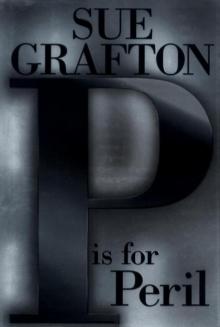 P Is for Peril
P Is for Peril R Is for Ricochet
R Is for Ricochet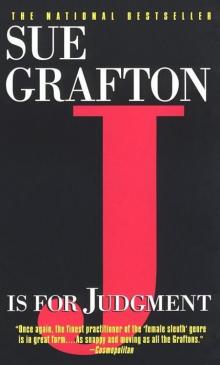 J Is for Judgment
J Is for Judgment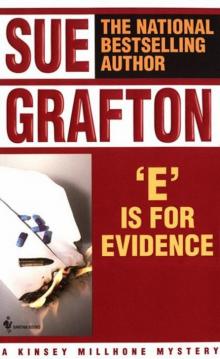 E Is for Evidence
E Is for Evidence T Is for Trespass
T Is for Trespass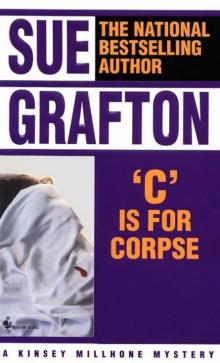 C Is for Corpse
C Is for Corpse U Is for Undertow
U Is for Undertow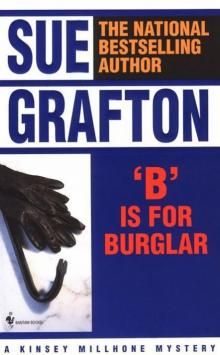 B Is for Burglar
B Is for Burglar Four Sue Grafton Novels
Four Sue Grafton Novels D Is for Deadbeat
D Is for Deadbeat K Is for Killer
K Is for Killer I Is for Innocent
I Is for Innocent A Is for Alibi
A Is for Alibi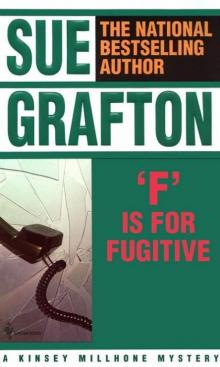 F Is for Fugitive
F Is for Fugitive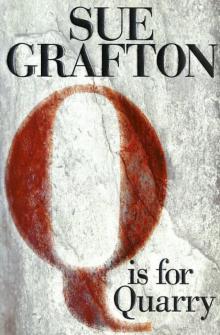 Q Is for Quarry
Q Is for Quarry W Is for Wasted
W Is for Wasted Kinsey and Me: Stories
Kinsey and Me: Stories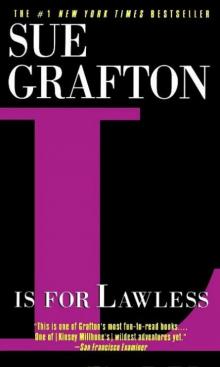 L Is for Lawless
L Is for Lawless Y Is for Yesterday
Y Is for Yesterday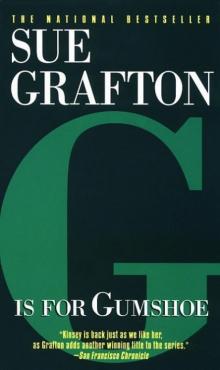 G Is for Gumshoe
G Is for Gumshoe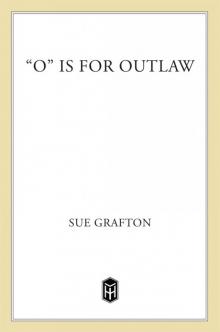 O Is for Outlaw
O Is for Outlaw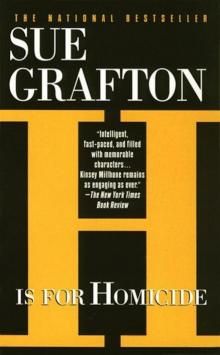 H Is for Homicide
H Is for Homicide X
X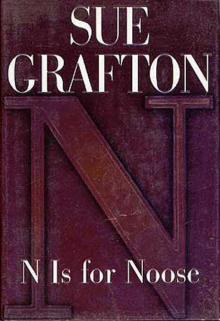 N Is for Noose
N Is for Noose Three Complete Novels: A Is for Alibi / B Is for Burglar / C Is for Corpse
Three Complete Novels: A Is for Alibi / B Is for Burglar / C Is for Corpse M Is for Malice
M Is for Malice I is for INNOCENT
I is for INNOCENT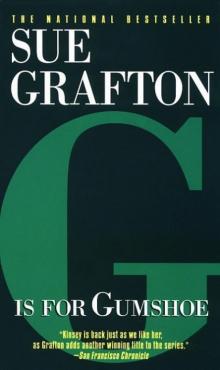 G is for GUMSHOE
G is for GUMSHOE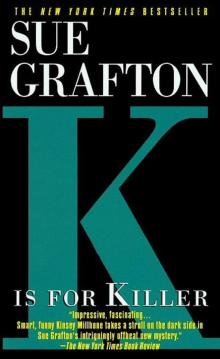 K is for KILLER
K is for KILLER S is for SILENCE
S is for SILENCE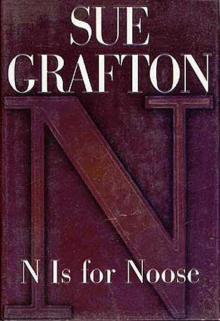 N is for NOOSE
N is for NOOSE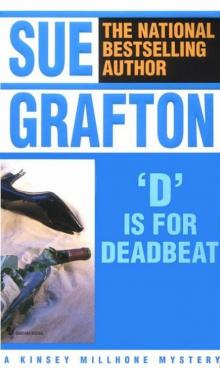 D is for DEADBEAT
D is for DEADBEAT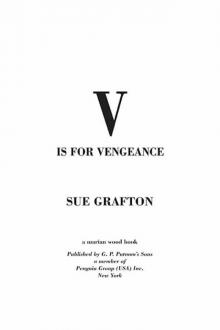 V is for Vengeance
V is for Vengeance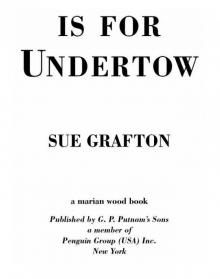 U is for Undertow
U is for Undertow W Is for Wasted km-23
W Is for Wasted km-23 O is for OUTLAW
O is for OUTLAW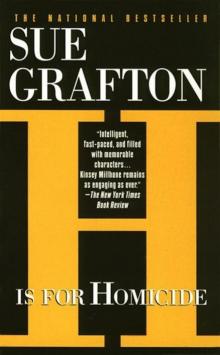 H is for HOMICIDE
H is for HOMICIDE Sue Grafton Novel Collection
Sue Grafton Novel Collection Kinsey and Me
Kinsey and Me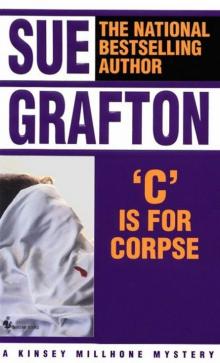 C is for CORPSE
C is for CORPSE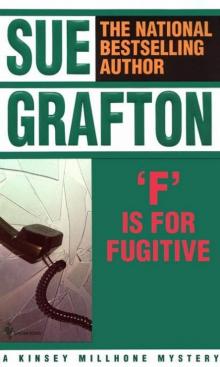 F is for FUGITIVE
F is for FUGITIVE B is for BURGLAR
B is for BURGLAR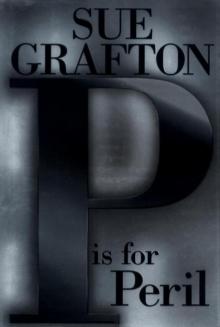 P is for PERIL
P is for PERIL A is for ALIBI
A is for ALIBI E is for EVIDENCE
E is for EVIDENCE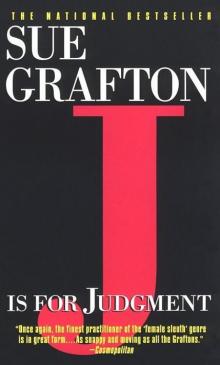 J is for JUDGMENT
J is for JUDGMENT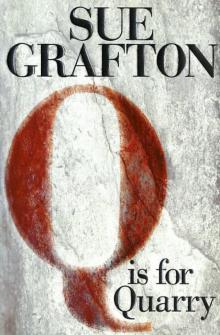 Q is for QUARRY
Q is for QUARRY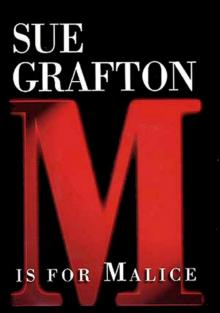 M is for MALICE
M is for MALICE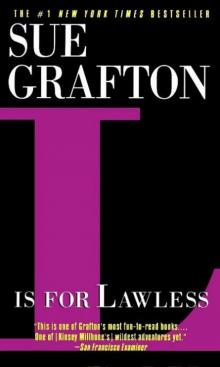 L is for LAWLESS
L is for LAWLESS